
Plant May month
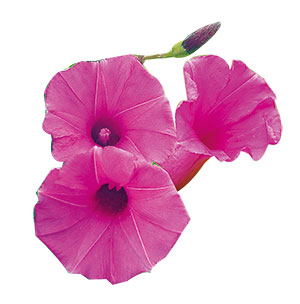 Purple Morning Glory
Purple Morning Glory
Found in the drier parts of the Eastern and Western Ghats, Purple Morning Glory or Argyreia cuneata Ker Gawl is a little known wild ornamental species worth introducing in gardens. The plant’s brightly-coloured trumpet-shaped flowers easily become a favourite of gardeners. It is also a hardy eye-catching plant. Unlike other ornamental morning glories, this one is not invasive in nature. It has a profusion of flowers, many large, up to 5 cm across. A sprinkling of bright pink flowers on dark green foliage always lifts any garden. Purple Morning Glory can be clipped since its large clumps can sprawl on a trellis or run wild over a fence as a climber. It twines on all types of supports-vertical, horizontal or drooping. This kind of versatile role is played by very few species.
Ylang Ylang Vine
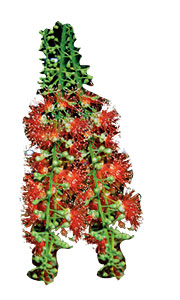 Is there anyone who isn’t enchanted by the fragrance of this flower? Ylang Ylang Vine is highly recommended for religious purposes especially during the worship of the gods. It is believed that the person who offers this flower to the gods is instantly blessed. Popularly known as Manoranjita in most Indian languages, it is a large climber with highly intoxicating flowers. The vine flowers throughout the year. Its flowers are large and green and turn yellow when they mature. Ylang Ylang can be used to cover high walls or fences effectively. Bare walls can be decorated by growing this climber with its very shiny leaves. As it can easily grow vertically, it can be used to cover tall pergolas and roof-top structures in gardens. It is good at concealing unattractive structures and landscape features. Ylang Ylang is used to combat fever and as an antiseptic, aphrodisiac and hair tonic.
Is there anyone who isn’t enchanted by the fragrance of this flower? Ylang Ylang Vine is highly recommended for religious purposes especially during the worship of the gods. It is believed that the person who offers this flower to the gods is instantly blessed. Popularly known as Manoranjita in most Indian languages, it is a large climber with highly intoxicating flowers. The vine flowers throughout the year. Its flowers are large and green and turn yellow when they mature. Ylang Ylang can be used to cover high walls or fences effectively. Bare walls can be decorated by growing this climber with its very shiny leaves. As it can easily grow vertically, it can be used to cover tall pergolas and roof-top structures in gardens. It is good at concealing unattractive structures and landscape features. Ylang Ylang is used to combat fever and as an antiseptic, aphrodisiac and hair tonic.
Wild Jack
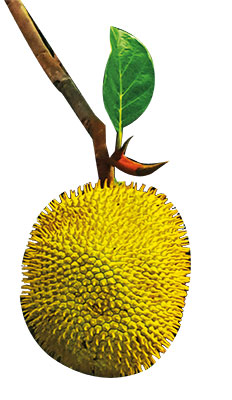 Wild jackfruit or Artocarpus hirsutus Lam finds pride of place in Indian kitchens. Wild Jack is a relative of our common jackfruit tree. Its ripe fruit is edible and sweet in taste. It is used to reduce body heat and treat anorexia (loss of appetite, taste, etc.). The fruit is also reportedly an aphrodisiac. Its
Wild jackfruit or Artocarpus hirsutus Lam finds pride of place in Indian kitchens. Wild Jack is a relative of our common jackfruit tree. Its ripe fruit is edible and sweet in taste. It is used to reduce body heat and treat anorexia (loss of appetite, taste, etc.). The fruit is also reportedly an aphrodisiac. Its
fresh leaves are used as fodder for elephants and its fallen leaves are one of the best organic
mulching ingredients for plant growth. The wood of the Wild Jack is used for house construction, boat-building and making furniture. Wild Jack is a lofty evergreen tree. Flowers are propped on 15-cm-long
spikes, minute and greenish yellow in colour. Fruits are aggregated, globose to ovoid, covered with spine-like projections and orange-yellow when ripe. The tree is
endemic to the Western Ghats of the southern states of Karnataka, Kerala, Maharashtra and Tamil Nadu.
Indian Oak
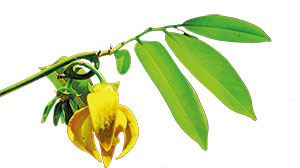 The Indian Oak is one of the most beautiful trees on Mother Earth. It is a freshwater as well as a marine loving evergreen and partially deciduous tree extensively used in the Ayurveda and Siddha systems of medicine. Numerous hanging racemes, up to 60 cm long, make this tree stunning and it enhances the landscape around it. It has large flowers with numerous pinkish-white stamens which turn bright red post pollination. Indian Oak also has large and shining foliage, making it a lovely shade tree. It can be used to enhance building designs. Its flowers have a pleasing mild aroma. The tree can be planted in a row in gardens to serve as a decorative border. It can also be used as a windscreen or to create a private space. The tree attracts many pollinators, creating natural elements in urban settings. In traditional medicine Indian Oak is used to treat skin diseases, vomiting and diarrhoea.
The Indian Oak is one of the most beautiful trees on Mother Earth. It is a freshwater as well as a marine loving evergreen and partially deciduous tree extensively used in the Ayurveda and Siddha systems of medicine. Numerous hanging racemes, up to 60 cm long, make this tree stunning and it enhances the landscape around it. It has large flowers with numerous pinkish-white stamens which turn bright red post pollination. Indian Oak also has large and shining foliage, making it a lovely shade tree. It can be used to enhance building designs. Its flowers have a pleasing mild aroma. The tree can be planted in a row in gardens to serve as a decorative border. It can also be used as a windscreen or to create a private space. The tree attracts many pollinators, creating natural elements in urban settings. In traditional medicine Indian Oak is used to treat skin diseases, vomiting and diarrhoea.
The Calacanthus
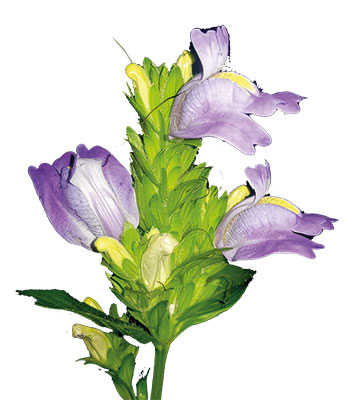 The Large-flowered Calacanthus or Calacanthus grandiflorus (Dalzell) Radlk., is a shrubby perennial that adds a dramatic look to any landscape. It is native to India. The plant produces large conical spikes with large, showy flowers and remains in bloom almost throughout the year thereby competing with exotic ornamental plants. Hence, this plant can keep the garden radiant and colourful all through the year. Its shiny green foliage contrasts attractively with its striking blue flowers. It is a beautiful addition to any garden when planted sensibly. Best of all, it is a shrub that does not require routine maintenance — like clipping, pruning, clearing.
The Large-flowered Calacanthus or Calacanthus grandiflorus (Dalzell) Radlk., is a shrubby perennial that adds a dramatic look to any landscape. It is native to India. The plant produces large conical spikes with large, showy flowers and remains in bloom almost throughout the year thereby competing with exotic ornamental plants. Hence, this plant can keep the garden radiant and colourful all through the year. Its shiny green foliage contrasts attractively with its striking blue flowers. It is a beautiful addition to any garden when planted sensibly. Best of all, it is a shrub that does not require routine maintenance — like clipping, pruning, clearing.
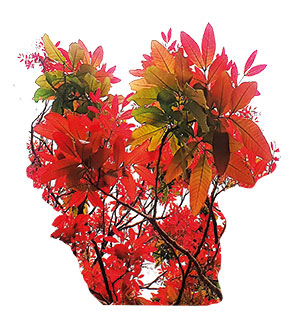 Kusum Tree
Kusum Tree
The Kusum tree is a monotypic genus in the family Sapindaceae. It can become a tall or a medium in height tree depending on the type of forest it finds itself in. It has a straight trunk and a very large, shade-spreading crown. In summer it is a cool tree to sit under and best suited for warm areas and hot summers. The tree’s tender leaves turn to various shades of red from March to April making it look rather spectacular both in natural and man-made environments. Its flowers appear in long racemes interspersed with new foliage. Fruits are drupes, often echinate (thorn-like). Seeds are embedded in pulpy, tasty arils. The Kusum tree is used to treat skin troubles, rheumatism, and to combat hairfall. Kusum oil obtained from its seeds is handy for culinary uses and for lighting lamps. Its tender leaves are used as fodder for cattle. It is also a prominent nectar plant for bees!
Comments
Currently there are no Comments. Be first to write a comment!



